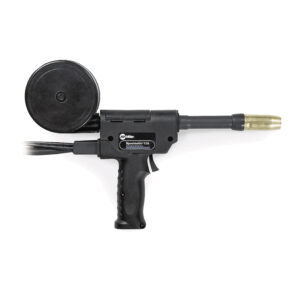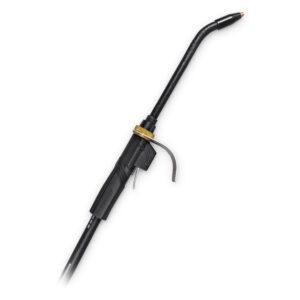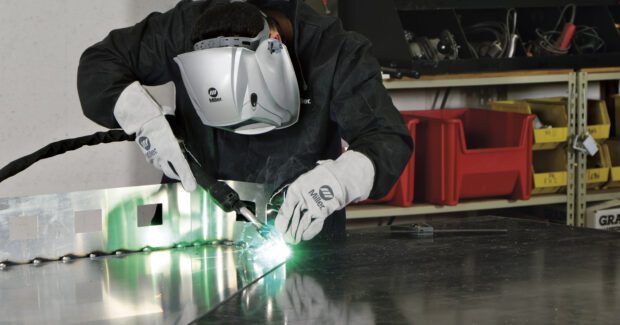Understanding the Many Types of MIG Guns
There are a variety of guns to select from regarding the MIG welding process. Learn all about the different types and customizations.
Posted: January 15, 2025

In MIG welding, there is no one-size-fits-all gun. Traditional MIG guns are the gold standard, but depending on the application, sometimes having a more specialized gun provides operators with greater flexibility and promotes enhanced outcomes. In addition to the different types of guns, there are various customizations that operators can use to enhance the welding experience and improve their welds. Here’s a look at the types of MIG guns that are available and how they can be personalized for maximum comfort and output.
Push-pull Guns
When an operator needs to be a significant distance away from the workpiece, a traditional MIG gun typically won’t cut it — especially when working with aluminum. Because it has a really low columnar strength — which is the material’s ability to resist bending or buckling when force is applied — aluminum has a lower tolerance to being pushed from a traditional wire feeder and can only be pushed a certain distance before it starts bird-nesting anywhere from contact tip to the drive roll. Using a push-pull gun mitigates this issue and allows operators to gain distance without sacrificing weld quality.

With a push-pull gun, a motor in the gun pulls the wire through the liner, while the motor in the welder or feeder control becomes an assist motor. This push-pull system creates consistent tension on the wire, which ultimately prevents bird-nesting. It also allows for cables up to 50’ long — a significant benefit that means the operator doesn’t have to reposition equipment to get the weld completed. Operators need continuous welds with minimal starts and stops, so having the ability to maintain the weld with the increased cable length improves productivity.
Push-pull guns typically come with a pistol grip, but a standard-style grip is also an option. A pistol grip handle is shaped like the grip of a pistol. Designed for comfort and better ergonomics, the trigger is located in an easy-to-reach position, similar to pulling a gun trigger. A standard-style grip is a straight, cylindrical handle that resembles a torch or stick, making it a more linear option. Similar to standard MIG guns, standard-style grip guns come in air-cooled and water-cooled options to align with needs for arc-on and duty cycles. Ultimately, the choice of a pistol or standard-style grip comes down to operator preference and the needs of the application.
Spool Guns
While the push-pull gun increases the distance an operator can be from the power source, a spool gun doubles down on that advantage. An operator can get even farther away because wire isn’t pushed from a feeder anymore. In this case, there’s a one- or two-pound spool sitting on top of the grip that creates a short and straight feed path. With the right cable size, there’s no limitation to how far away an operator can be from the power source. Of course, the farther away from the power source, the greater the likelihood that there will be incremental drops in power delivery, which can negatively impact weld quality. Some manufacturers have equipment with technology that helps compensate for power drops across extra-long cables, helping to eliminate that issue on the job. If operators don’t have access to that equipment, they need to determine what the sweet spot is between distance and maintaining weld quality.
There are a few other considerations to weigh when choosing between a push-pull and spool gun. While both types work well for aluminum applications, spool gun operators have to change the roll of wire after every pound used, whereas a push-pull system can accommodate much larger spools. When an operator is using several pounds of aluminum wire per day, the time needed to change spools can add up. Spool guns may also limit access in tighter spaces, which would require the use of a longer stick-out that could be hard to maneuver. For operators looking for added options on this gun, using standard or tapered contact tips or swapping out the neck can up the personalization factor to better meet the application’s needs.
Flux-cored Guns

When welding outdoors or working with high-strength applications, a flux-cored MIG gun is an ideal choice, especially in environments where shielding gas setups are impractical. For structural applications, operators are beginning to make the switch to flux-cored welding from stick welding. That’s because flux-cored welding offers greater travel speeds and deposition rates compared to stick welding and also eliminates the frequent stops and starts associated with changing out stick electrodes.
What makes flux-cored guns unique is the fact that they don’t require the same components as traditional MIG guns or a shielding gas to protect the weld pool. This type of gun is designed to handle flux-cored wires, which have a hollow core filled with flux that creates shielding gas as it burns to protect the weld from contaminants. This eliminates the cost of and need for buying and storing gas containers onsite.
As flux-cored guns become more widely used, manufacturers are finding ways to modernize what a traditional flux-cored gun has always looked like. Newer models, like the IronPro™ self-shielded flux-cored gun from Bernard, have a design that more closely resembles a standard MIG gun but also feature ergonomics that are more conducive and comfortable for all-day use. Added neck options, heat shields and dual schedule switches also deliver more paths to optimization, helping make the latest flux-cored guns more ergonomically and aesthetically consistent with standard guns.
Traditional MIG Guns
You can’t overlook a classic, and MIG guns can virtually do it all if given the opportunity. Proper cooling of these guns is essential to protect both equipment and operators from the intense heat of the welding arc and the electrical components. To beat both types of heat, operators can choose from air- or water-cooled systems.
An air-cooled system relies on the ambient air and shielding gas to dissipate heat that builds up along the length of the welding circuit. A water-cooled system pumps a cooling solution from a radiator unit through cooling hoses inside the power cable and into the gun handle, neck and consumables. The coolant returns to the radiator where the radiator’s baffling system releases the heat absorbed by the coolant.
When deciding between the two, the welding amperage will be a determining factor to consider. In general, air-cooled systems are better for low amperages (150-to-600 amps) with shorter arc-on time, and water-cooled systems are better for high-amperage applications (300-to-600 amps) with longer arc-on times.
For these welding workhorses, an operator can further personalize their MIG gun in several practical ways to improve comfort, efficiency and control:
- Handles: There are a variety of grip handle styles to choose from, with ergonomic options available to reduce fatigue, which is helpful for extended use.
- Contact tips and nozzles: There are many options for contact tips, ranging from standard to tapered. Standard contact tips can be used with standard nozzles, threaded or slip-on, where access is not a concern and gas coverage is critical. Tapered contact tips, along with tapered nozzles, are beneficial in tight access areas.
- Triggers: There’s a wide variety of trigger options, ranging from paddles to buttons, which allow an operator to feel as comfortable as possible throughout the duration of their shift.
- Cable length: For semi-automatic MIG gun applications, the cable length can be customizable to meet a customer’s requirements.
Making MIG Guns Work Hard — No Matter What
Standard semi-automatic MIG guns are a versatile and reliable option across many applications. When more specific needs arise, niche guns make it possible to address unique welding challenges. Between these specialty guns and the myriad of ways to customize MIG guns, operators have the opportunity to significantly improve their user experience and enhance their arc-on time, no matter the situation or application.



















